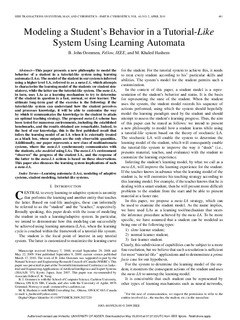| dc.contributor.author | Oommen, B. John | |
| dc.contributor.author | Hashem, M. Khaled | |
| dc.date.accessioned | 2010-11-29T13:37:18Z | |
| dc.date.available | 2010-11-29T13:37:18Z | |
| dc.date.issued | 2010 | |
| dc.identifier.citation | Oommen, B.J. & Hashem. M.K. (2010). Modeling a Student's Behavior in a Tutorial-Like System Using Learning Automata. IEEE Transactions on Systems, Man, and Cybernetics, Part B: Cybernetics. vol. 40, no. 2. DOI: 10.1109/TSMCB.2009.2032414 | en_US |
| dc.identifier.issn | 1941-0492 | |
| dc.identifier.uri | http://hdl.handle.net/11250/137845 | |
| dc.description | Published version of an article in the journal: IEEE Transactions on Systems, Man, and Cybernetics, Part B: Cybernetics. Personal use of this material is permitted. Permission from IEEE must be obtained for all other users, including reprinting/ republishing this material for advertising or promotional purposes, creating new collective works for resale or redistribution to servers or lists, or reuse of any copyrighted components of this work in other works | en_US |
| dc.description.abstract | This paper presents a new philosophy to model the behavior of a student in a tutorial- like system using learning automata (LAs). The model of the student in our system is inferred using a higher level LA, referred to as a meta-LA , which attempts to characterize the learning model of the students (or student simulators), while the latter use the tutorial-like system. The meta-LA , in turn, uses LAs as a learning mechanism to try to determine if the student in question is a fast, normal, or slow learner. The ultimate long-term goal of the exercise is the following: if the tutorial- like system can understand how the student perceives and processes knowledge, it will be able to customize the way by which it communicates the knowledge to the student to attain an optimal teaching strategy. The proposed meta-LA scheme has been tested for numerous environments, including the established benchmarks, and the results obtained are remarkable. Indeed, to the best of our knowledge, this is the first published result that infers the learning model of an LA when it is externally treated as a black box, whose outputs are the only observable quantities. Additionally, our paper represents a new class of multiautomata systems, where the meta-LA synchronously communicates with the students, also modeled using LAs. The meta-LA's environment ¿observes¿ the progress of the student LA, and the response of the latter to the meta-LA actions is based on these observations. This paper also discusses the learning system implications of such a meta-LA. | en_US |
| dc.language.iso | eng | en_US |
| dc.publisher | IEEE | en_US |
| dc.title | Modeling a Student's Behavior in a Tutorial-Like System Using Learning Automata | en_US |
| dc.type | Journal article | en_US |
| dc.type | Peer reviewed | en_US |
| dc.source.pagenumber | 481-492 | en_US |
| dc.source.journal | IEEE Transactions on Cybernetics | |
